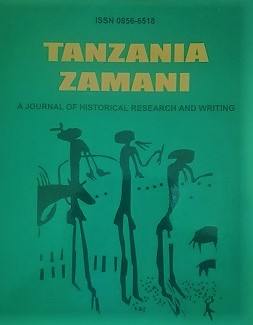Tanzania ' s Gold Mining Industry: The Case of the Lake Province, 1940s to the early 1970s
Abstract
Between 1941 and the early 1970s, Tanzania ' s gold mining industry underwent fundamental changes. Hit hard by rising production costs at a time the international price of gold remained pegged at US $35 per ounce, the industry ' s importance to the country ' s economy declined. In the early 1940s, gold was the most important mineral in Tanzania and its production had reached a peak of four tones a year.[1] Then gold was the second major foreign currency earner after sisal. However, from 1941, gold production declined. By the early 1970s, almost all Tanzania ' s big gold mines had closed, and official production dropped off to virtually zero.[2]
Scholars do not disagree that the importance of gold to the economy during the post-Second World War declined. However, this decline has often been overstated and mischaracterized.[3] Scholars do not also agree on when, how and why this decline occurred. One group of scholars contends that Tanzania ' s gold mining industry never recovered from the effects of the Second World War. A.D. Roberts, for example, notes that "in Tanganyika, as in Kenya, gold mining never recovered from the [1941 American] Land-Lease."[4] Another group of scholars blame Julius Nyerere ' s socialist policy for the collapse of the mining industry. T.L. Maliyamkono and H. Mason, for example, assert that "most gold mines that were opened during the colonial period closed down around the time the country gained independence in 1961 due to changes in the political climate and socio-economic policies."[5] Paul Jourdan also argues along the same lines. He writes: "Following the spirit of the Arusha Declaration of 1967, the State progressively took over the national mining industry so that by the mid-seventies the private mining sector had all but disappeared." He continues, "The collapse of the mineral sector from 1967 onwards amply demonstrated that the state was not able to develop or manage this sector."[6]This position, as well as the one above, is based on unproven claims.
[1]S.C. Chachage. "The Meek Shall Inherit the Earth, but not the Mining Rights: The Mining Industry and Accumulation in Tanzania." In P. Gibbon (ed.). Liberalised Development in Tanzania, (Uppsala: Nordiska Afrikainstitutet, 1995), p. 52.
[2] Paul Jordan. "Minerals Industry of Tanzania" (Institute of Mining Research, University of Zimbabwe: Unpublished paper, n.d.), p.8; Mark E. Parker. "The Mining Industry in Tanzania (Geological Survey of Tanzania: Unpublished paper, 1991), pp. 15-18.
[3] A.D. Roberts, for example, asserts that "in Tanganyika, as in Kenya, gold mining never recovered from the [1941 American] Land-Lease." A.D. Roberts."The Gold Boom of the 1930s in Eastern Africa."African Affairs, Vol. 85, No. 384 (1984), p.560. The 1941 American Land-Lease was a program whereby the U.S. government provided food, machinery and general supplies to countries which it considered critical for the war effort. Through this program, the U.S. government was able to influence the economic policies of many countries, including Tanganyika. Because gold and other commodities were removed from the list of "scheduled commodities," the industry could not get assistance from the state.
[4] Roberts, "The Gold Boom of the 1930s,"p. 560.
[5] T.L. Maliyamkono and H. Mason. The Promise (Dar es Salaam: Tema Publishers Co., 2006), p.295.
[6] P. Jourdan, Minerals Industry of Tanzania, p. 4
Previously unused mining records in Mwanza Regional Mines Offices and Geological Survey of Tanzania Offices in Dodoma indicate that, while gold production declined in the Southern Province, the major source of the country ' s gold before the Second World War, in the Lake Province, where all of the country ' s large mines were located, gold production increased until at least the end of the 1950s. These hitherto unused files, some of which were stacked in sacks and heaped in a storeroom in 2008/9 at Mwanza Regional Mines Office, included annual mining reports for the Province and the Inspector of Mines ' reports. These were critical in mapping out the trajectory of gold mining in the Lake Province from the 1930s to the late 1950s. As mentioned above, they show that contrary to the conventional wisdom that the Second World War marked the start of the decline of the gold mining industry, production actually increased in this region. The Province ' s large mines eventually closed in the late 1960s and early 1970s under the weight of rising mining costs at a time the price of gold remained fixed at US $35 per ounce, but not because of the economic policies of Nyerere ' s government, which scholars often blame for the collapse of the mining industry.[1] More important still, mining records and oral interviews reveal a previously unrecognized dynamism within the gold mining industry, which one representative of white miners described in 1949 as experiencing "a crisis" and "dying."[2] If white miners were correct in characterizing the industry then as in "a crisis" and "dying," they were wrong to portray their own decline as a crisis that plagued the whole industry. African small-scale miners proved more resilient than large-scale white miners in coping with the "crisis" that was caused by rising mining costs. In fact, the crisis in the large-scale sector opened opportunities for African miners who survived it due to the fact that they sold their gold in the more lucrative black market and also because the size of their operations allowed them to be more flexible than big companies.
[1] For accounts that blame Nyerere ' s economic policies for the collapse of the mining sector see, for example, Maliyamkono and Mason, The Promise, p. 295. and Paul Jordan, Minerals Industry of Tanzania, pp. 4-6.
[2] Tanzania National Archives [Hereafter TNA], Dodoma Offices, File 7437; N. Chand, President of Musoma Mining Association, to the Officer in Charge, Land and Mines, February 1, 1949.


